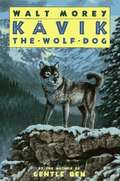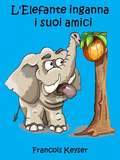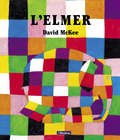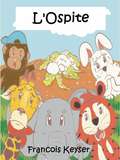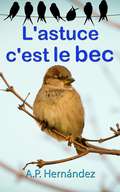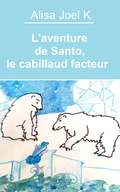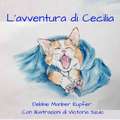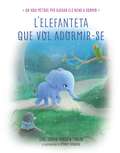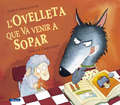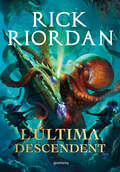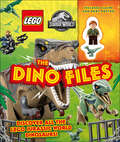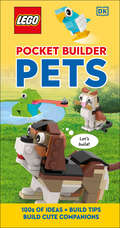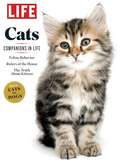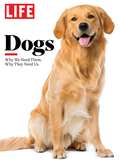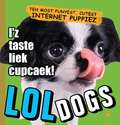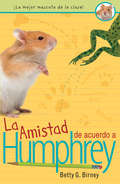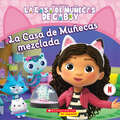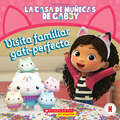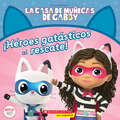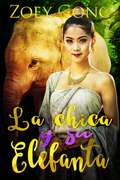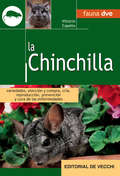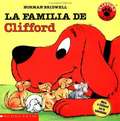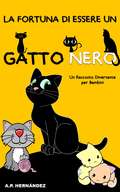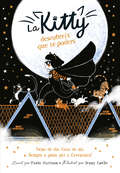- Table View
- List View
Kävik, the Wolf Dog
by Walt MoreyKävik, a wolf dog, is involved in a plane crash on his way to California, where his new owner lives. Andy Evans finds him and with the help of his family nurses Kävik and saves his life. Soon, Kärik is well and is taken to his rightful owner. After weeks, Kävik escapes from his owner and returns to Andy Evans.
L'Elefante inganna i suoi amici: Una storia che insegna come utilizzare la natura per vivere in armonia con gli animali.
by Francois KeyserL'elefante è affamato, dopo un po' di esplorazione scopre un campo pieno di carote e banane ma c'è un problema... Ci sono api tra lui e le deliziose banane e carote e gli elefanti hanno paura delle api. L'elefante pensa a un modo per prendere le carote e le banane senza essere punto. Arruola l'aiuto dei suoi amici il Coniglio e la Scimmia. Non pensa che vengano punti dalle api ma opportunamente si scorda di informarli riguardo alle api. Quando il piano dell'Elefante va terribilmente storto e i suoi amici realizzano che era a conoscenza delle api decidono di insegnargli una lezione.
L'Elmer (L'Elmer. Primeres lectures #1)
by David MckeeL'Elmer no és com els altres elefants del ramat. Encara que sembli impossible, és un elefant de mil colors: verd, blau, rosa, blanc, groc... Impressionant!, oi? Però a l'Elmer no l'hi fa ni gota de gràcia ser així, més aviat està fart de ser diferent; així que un dia decideix escapar-se del ramat i cercar un remei per poder ser del mateix colors que els altres... Format especial per a tot tipus de dispositius electrònics.
L'Ospite
by Francois KeyserIn questo libro della serie "Gli amici della Giungla" è arrivato un ospite affamato nella giungla. Quando Raff vede l'ospite, sembra che l'ospite abbia già mangiato il suo amico, Giglio il Coniglio. Raff deve trovare i suoi altri amici e avvisarli del pericoloso ospite. Riuscirà a raggiungere i suoi amici prima che l'ospite se li mangi o l'ospite mangerà Raff prima che lui riesca ad avvertire i suoi amici?
L'astuce, c'est le bec
by A. P. HernándezÀ partir de huit ans. Livre ingénieux et amusant pour apprendre du vocabulaire, la conscience de soi et réfléchir sur la valeur des choses matérielles Albert est un moineau très particulier. Tous les jours il passe des heures à lisser et astiquer méticuleusement ses plumes pour être resplandissant. Pour Albert, le plus important est d'avoir un aspect toujours parfait. Sa réputation est telle que tous les oiseaux de toutes les espèces et de tous les coins de la planète assistent à sa sequoya-académie pour prendre des cours de toilettage. Mais quelque chose perturbe sa tranquillité. Un matin, au réveil, Albert découvre qu'il a été victime du terrible vol… Un livre amusant pour les enfants et un recours didactique pour les parents, pédagogues, instituteurs et psychologues pour travailler l'estime de soi et des valeurs comme l'amitié et l'altruisme.
L'aventure de Santo, le cabillaud facteur (L'aventure de Santo, le facteur cabillaud #1)
by Alisa Joel KLe facteur du service postal maritime, Santo, assume une mission spéciale : retrouver l’expédition disparue. Dans ses recherches, en voyageant du Pôle Nord au Pôle Sud, il connaît la diversité de la vie dans l’océan et ses problèmes. Santo parviendra-t-il à sauver la réputation de la poste maritime malgré l’opposition des méchants de la mer ? Car il semble que de la réception de l’expédition dépend l’issue du conflit séculaire entre le Royaume des Manchots et l’Empire des Ours Blancs.
L'avventura di Cecilia
by Debbie Manber Kupfer Ilaria SabatelliCecilia è alla ricerca del suo nuovo umano, ma troverà quello giusto? Ha sentito dire che sono molto difficili da addestrare. Dall’ autrice dei Racconti da O.R.M.A. ed Esmeralda Grunch e il Tulipano Rosso. Con illustrazioni di Victoria Szulc
L'elefanteta que vol adormir-se
by Carl-Johan Forssén EhrlinL'elefanteta que vol adormir-se és l'esperada continuació del bestseller mundial El conillet que vol adormir-se. Un nou mètode per ajudar els nens a dormir, una eina revolucionaria recomanada i elogiada per pares, psicòlegs i terapeutes.. Acompanyeu a l'elefanteta Helena mentre creua un bosc màgic que l'ha de dur al país dels somnis. Pel camí l'Helena i l'infant es trobaran amb personatges fantàstics i viuran aventures relaxants que els ajudaran a calmar-se i a agafar el son ràpidament, tant a la migdiada com a la nit. Els contes de Carl-Johan Forssén Ehrlin s'han traduït a diverses llengües i, gràcies a les seves innovadores tècniques psicològiques, s'han convertit en un mètode revolucionari que ja ha ajudat a milers de pares arreu del món a aconseguir que els seus fills agafin el son. Escrits en llenguatge senzill, aquests contes fan que els nens es relaxin is'adormin fins i tot abans d'acabar la lectura. Ressenyes i opinions de lectors sobre El conillet que vol adormir-se:«El llibre, número u en vendes en diversos països, aconsegueix que els nens s'adormin sense problemes.»ABC «Pares esgotats del món, això és el que estàveu esperant. Si encara no teniu una còpia, heu de comprar-ne una quan abans.»Metro «L'hora d'anar a dormir més tranquil·la que hem tingut en mesos.»Daily Mail «Màgia en un llibre.» «Guauuu... simplement guauuu.» «Un llibre fantàstic.» «Funciona tal com diuennnzzz...» «100% recomanable.»
L'ovelleta que va venir a sopar (L'ovelleta que va venir a sopar #Volumen)
by Steve Smallman Joëlle DreidemyL'ovelleta que va venir a sopar es un conte deliciós ple de valors com l'amistat, la generositat i l'acceptació de les diferencies. A casa del vell llop afamat per sopar sempre hi ha una miserable sopa de verdures!!! Però una nit, truquen a la porta de la petita cabana i es tracta ni més ni menys que d'un pobre xaiet que s'ha perdut. El llop llavors comença a planificar l'estofat suculent amb què s'omplirà l'estómac... Però el be no vol convertir-se en el gran menjar del llop, el que vol és ser el seu amic!Una entranyable història d'amistat.
L'última descendent
by Rick RiordanUN SECRET A LES PROFUNDITATS DE L'OCEÀ UNA BATALLA SOTA EL MAR PER DESCOBRIR LA VERITAT L'Acadèmia Harding-Pencroft no és un institut normal: de les seves classes en surten els millors exploradors submarins i els navegants més prestigiosos del món, que competeixen en condicions extremes dividits entre les cases Dofí, Cefalòpode, Orca i Tauró . Ana Dakkar, una brillant estudiant de primer any, està preparada per a la misteriosa prova de final de curs... fins que una terrible tragèdia canvia el seu destí per sempre. En una cursa contra enemics mortals i trampes submarines, descobrirà que el secret més ben guardat de l'escola està en les profunditats de l'oceà, i només una persona el podrà protegir... L'ÚLTIMA DESCENDENT
L. S. Dickey and the Valley Horsemen
by Sandra McintoshThe life of and stories about legendary Saddlebred trainer and dealer L. S. Dickey during the first half of the 20th century, in a time that grew a special breed of American Saddlebred horsemen. The stories of L. S. Dickey and his proteges from an area in southern Indiana simply known as "The Valley". These men went on to play a very important role in the Saddlebred world.
LEGO Jurassic World The Dino Files
by Catherine SaundersFrom T. rex to Triceratops, meet all the incredible dinos! Features a Claire minifigure and baby raptor!Explore LEGO® Jurassic World with Claire and Owen. Visit the laboratory where dinosaurs are created. Go for a ride in a Gyrosphere. Learn about the original Jurassic Park and marvel at the sights. Features fascinating real-world dinosaur facts! LEGO Jurassic World: The Dino Files comes with a Claire minifigure and baby raptor. ©2021 The LEGO Group. ©2021 Universal Studios.
LEGO Pocket Builder Pets: Build Cute Companions (LEGO Pocket Builder)
by DKBuild your LEGOⓇ skills with this bite-size guide!Become a LEGOⓇ building expert with stacks of facts, tips, and tricks at your fingertips—no previous building experience required! Get out your bricks and be inspired to build your favorite real and fantasy pets, including cats, dogs, rabbits, fish, unicorns, and much more. Plus learn to build homes and accessories for your brick-built buddies. Each LEGO Pocket Builder book is packed with images of fun-to-make models, building techniques, advice, and inspiration—plus they are perfectly pocket-sized for building anywhere—even on-the-go. Grab your LEGO bricks and get building!
LIFE Cats
by The Editors of LIFECats, the new special edition from LIFE, takes an in-depth look at the world's most popular pet, the only domesticated animal that remains almost as wild as its ancient ancestors, which might explain why they rarely do what we want them to do or as we expect them to do. Cats looks at the history of the house cat, secrets of cat behavior, and what you've always wondered: what exactly do cats do all day long when we're away at work or at school? Plus, the historic animosity between cats and dogs-how much is true, how much is manufactured? We also look at "miracle cats," adoption success stories, and this special edition features lots of great pictures of (what else?) cats.
LIFE Dogs: Why We Need Them. Why They Need Us.
by The Editors of LIFECelebrate man's best friend in this collector's edition, LIFE Dogs: Why We Need Them. Why They Need Us.
LOLdogs
by Editors of Amorata PressOMG! THOSE LOVEABLE LOLDOGS HAVE ESCAPED FROM THE INTERNET AND MADE THEIR OWN BOOK.Here are the cutest canines and cleverest captions combined for out-of-control puppy mayhem. From purebreds and mutts to purse dogs and work dogs, this is the ultimate collection of lol hilarious doggy fun, srsly.A perfect gift for dog- and humor-lovers everywhere, this book is packed with hundreds of LOLdogs doing ridiculous things - from house-destroying hounds to skateboard-riding scotties. Each photo features a clever caption that is not misspelled English but, in fact, perfectly accurate LOLspeak.
La Amistad de acuerdo a Humphrey (Humphrey #2)
by Betty G. BirneyEl segundo libro en el serie de la mejor mascota de la clase--ahora en Espanol!Hay una nueva mascota en el Aula 26: es una rana y se llama Og. Humphrey está deseando hacerse amigo de Og, pero Og no parece interesado. ¡Y, para colmo, los estudiantes están tan fascinados con Og que apenas prestan atención a Humphrey! Humphrey sabe que la amistad puede ser a veces algo complicado, pero si un hámster es capaz de hacerse amigo de una rana, ¡ese es Humphrey! ¡Humphrey es uno de los preferidos del programa ONE SCHOOL, ONE BOOK!¡Los libros de Humphrey han sido nominados a diferentes premios en veinticuatro estados del país resultando ganador en siete de ellos gracias a los votos de los niños!
La Casa de Muñecas de Gabby: La Casa de Muñecas mezclada (Gabby's Dollhouse: Mixed-Up Dollhouse)
by Violet ZhangThis 24-page storybook features your favorite characters from DreamWorks Gabby's Dollhouse!Gabby abre un globo de nieve con la forma de la Casa de Muñecas y se da cuenta de que las habitaciones del interior están todas mal. Y eso no es todo: cuando la sacude, la verdadera Casa de Muñecas también se vuelva patas arriba. ¡Únete a Gabby, Pandy y el resto de los gatitos en una aventura para arreglar las cosas!When Gabby unboxes a snow globe shaped like the Dollhouse, she notices the rooms inside are all mixed-up. And that's not all-giving it a shake makes the real Dollhouse go topsy-turvy, too! Join Gabby, Pandy, and the rest of the Gabby Cats on an adventure to set things straight!
La Casa de Muñecas de Gabby: Visita familiar gati-perfecta (Gabby's Dollhouse: Purr-fect Family Visit)
by Pamela BobowiczCakey’s cupcake cousins come to visit in this storybook based on the hit preschool show, DreamWorks Gabby’s Dollhouse!¡Pastelillo está muy emocionado porque sus primos vienen a visitar la Casa de Muñecas de Gabby! Hasta planificó el día perfecto. Pero sus primos tienen sus propias ideas sobre la diversión. ¿Podrán los amigos y la familia de Pastelillo ayudarlo a relajarse para que todos puedan pasar un día divertido juntos? DreamWorks La Casa de Muñecas de Gabby © 2022 DreamWorks Animation LLC. Todos los derechos reservados.Cakey Cat is so excited his cousins are visiting the Dollhouse with Gabby! He made a plan for the purr-fect day. But his cousins have their own ideas for having fun. Can Cakey’s friends and family help him go with the flow, so they can all have a paw-some day together? DreamWorks Gabby's Dollhouse © 2022 DreamWorks Animation LLC. All Rights Reserved.
La Casa de Muñecas de Gabby: ¡Héroes gatásticos al rescate! (Gabby's Dollhouse: Cat-tastic Heroes to the Rescue!)
by Gabhi MartinsDive into the world of DreamWorks Gabby's Dollhouse for a superhero adventure in this 24-page storybook that comes with stickers and punch-out trading cards!Cuando Gabby y Pandy abren una caja con una sorpresa para superhéroes, ¡se convierten en los Defensores de la Casa de Muñecas! Justo a tiempo, pues Escurrigato se ha convertido en un supervillano, ¡y Súper Gabby y Súper Pandy deberán salvar a Pastelillo y los demás gatos de Gabby!When Gabby and Pandy unbox a superhero surprise, they become the Dollhouse Defenders! It's just in time, too-CatRat has become a supervillain, and it's up to Super Gabby and Super Pandy to save Cakey and the rest of the Gabby Cats!
La Chica y su Elefanta (Compañeros Animales #1)
by Zoey GongUna elefanta muere durante el parto y el resto de elefantes lloran su pérdida. Kanita, la hija del cuidador de elefantes del rey, se niega a rendirse. Con sus propias manos ayuda a nacer a la pequeña elefanta, Safi. Desde ese momento comienza una amistad para toda la vida entre la chica y la elefanta. Muchos de los aldeanos están preocupados por la maldición de la elefanta blanca con una marca de nacimiento de color rojo en la cara. La vida idílica de Kanita, criada en las montañas del norte de Siam, se derrumba cuando le ordenan casarse con un hombre mucho mayor que ella y abandonar a la elefanta de la mala suerte. La naturaleza terca de Kanita se niega a ceder ante los deseos de sus padres así que huye con Safi para redimirla de su reputación maldita y fortalecer sus lazos, prometiendo no separarse nunca. Pero la selva es más peligrosa de lo que Kanita o Safi pueden imaginar. Sigue a Kanita y Safi por la selva del antiguo Siam en una historia de amistad, esperanza y redención. La chica y su elefanta es el primer libro de la serie Compañeros Animales. Cada libro es una novela única con aventuras y personajes nuevos.
La Chinchilla
by Vittorio Capello* He aquí un nuevo animal de compañía: la chinchilla. Se trata de un roedor del tamaño de un conejito, simpático, gracioso y con una piel espléndida y suave * ¿Qué más podemos saber de este animalito? ¿Dónde se compra? ¿Es un macho o una hembra? ¿En qué tipo de jaula debemos instalarlo? ¿Cómo podemos domesticarlo? ¿Cómo se comporta con los demás animales? ¿Es seguro para los niños? ¿Qué hacer para que esté siempre limpio y sano? ¿Qué come? ¿Cómo se reproduce? ¿Qué cuidados necesitan las crías? ¿Cómo sabremos si está enfermo? * Cuando se adquiere una chinchilla, hay que conocer la respuesta a todas estas preguntas. Esta guía nos explica cuál es la mejor forma y la más sencilla para solucionar todos los problemas que se nos pueden plantear * Un manual indispensable para quien ya posee un ejemplar de chinchilla, para quien se dispone a comprar una o para quien simplemente desea conocer este singular, bellísimo y tierno animal Vittorio Capello es médico veterinario especialista en pequeños animales de compañía, sobre todo en pequeños roedores. Ha publicado artículos sobre animales de compañía en revistas de medicina y colabora en algunas publicaciones del sector.
La Fortuna di Essere un Gatto Nero: Un Racconto Divertente per Bambini
by A. HernándezAlfredo è un gatto nero, l'unico gatto nero della sua famiglia. Non gli è mai importato del colore del suo pelo, ma una mattina i suoi genitori decidono di parlargli. Alfredo deve sapere qualcosa di molto importante: alcune persone credono che i gatti neri portino sfortuna. Alfredo diventa triste ma, col tempo, scoprirà quanto sia fortunato, in realtà.. Un libro per bambini che comprende numerose fotografie di gatti.
La Kitty descobreix que té poders (=^La Kitty^= #Volumen)
by Paula HarrisonNena de dia. Gata de nit.Sempre a punt per l'aventura. Una nova sèrie dels editors de «la Isadora Moon». La Kitty pot parlar amb els animals i té superpoders felins, però... estarà llesta per ser una superheroïna com la seva mare? A La Kitty descobreix que té poders...La família de la Kitty té un secret. La seva mare és una heroïna amb poders felins i la Kitty sap que, algun dia, ella també els haurà de fer servir. Aquest dia arriba molt abans que no pensava, quan Fígaro, el gat belluguet, apareix a la finestra de la seva habitació i li demana que l'ajudi. Però, per a la Kitty, la nit és aterridora. Aconseguirà ser prou valenta per endinsar-se en la foscor i viure aventures emocionants sota la llum de la lluna? Uneix-te a la Kitty i a la seva colla de gats per viure aventures fascinants!
